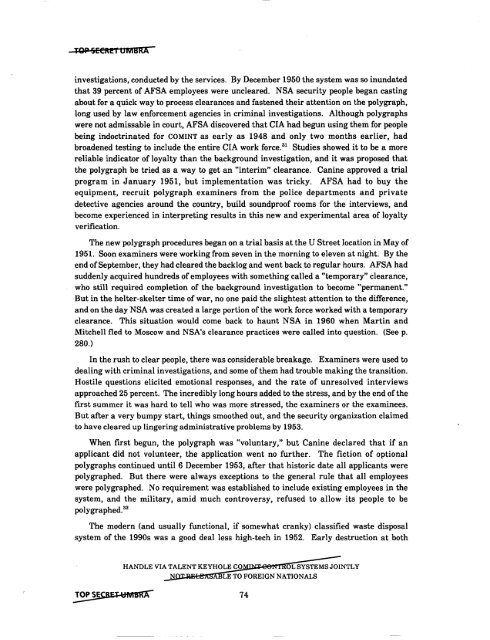American Cryptology during the Cold War - The Black Vault
American Cryptology during the Cold War - The Black Vault
American Cryptology during the Cold War - The Black Vault
Create successful ePaper yourself
Turn your PDF publications into a flip-book with our unique Google optimized e-Paper software.
Tgp SEER!T UMBRA<br />
investigations, conducted by <strong>the</strong> services. By December 1950 <strong>the</strong> system was so inundated<br />
that 39 percent of AFSA employees were uncleared. NSA security people began casting<br />
about for a quick way to process clearances and fastened <strong>the</strong>ir attention on <strong>the</strong> polygraph,<br />
long used by law enforcement agencies in criminal investigations. Although polygraphs<br />
were not admissable in court, AFSA discovered that CIA had begun using <strong>the</strong>m for people<br />
being indoctrinated for COMINT as early as 1948 and only two months earlier, had<br />
broadened testing to include <strong>the</strong> entire CIA work force. 31 Studies showed it to be a more<br />
reliable indicator of loyalty than <strong>the</strong> background investigation, and it was proposed that<br />
<strong>the</strong> polygraph be tried as a way to get an "interim" clearance. Canine approved a trial<br />
program in January 1951, but implementation was tricky. AFSA had to buy <strong>the</strong><br />
equipment, recruit polygraph examiners from <strong>the</strong> police departments and private<br />
detective agencies around <strong>the</strong> country, build soundproof rooms for <strong>the</strong> interviews, and<br />
become experienced in interpreting results in this new and experimental area of loyalty<br />
verification.<br />
<strong>The</strong> new polygraph procedures began on a trial basis at <strong>the</strong> U Street location in May of<br />
1951. Soon examiners were working from seven in <strong>the</strong> morning to eleven at night. By <strong>the</strong><br />
end ofSeptember, <strong>the</strong>y had cleared <strong>the</strong> backlog and went back to regular hours. AFSA had<br />
suddenly acquired hundreds ofemployees with something called a "temporary" clearance,<br />
who still required completion of <strong>the</strong> background investigation to become "permanent."<br />
But in <strong>the</strong> helter-skelter time of war, no one paid <strong>the</strong> slightest attention to <strong>the</strong> difference,<br />
and on <strong>the</strong> day NSA was created a large portion of<strong>the</strong> work force worked with a temporary<br />
clearance. This situation would come back to haunt NSA in 1960 when Martin and<br />
Mitchell fled to Moscow and NSA's clearance practices were called into question. (See p.<br />
280.)<br />
In <strong>the</strong> rush to clear people, <strong>the</strong>re was considerable breakage. Examiners were used to<br />
dealing with criminal investigations, and some of<strong>the</strong>m had trouble making <strong>the</strong> transition.<br />
Hostile questions elicited emotional responses, and <strong>the</strong> rate of unresolved interviews<br />
approached 25 percent. <strong>The</strong> incredibly long hours added to <strong>the</strong> stress, and by <strong>the</strong> end of<strong>the</strong><br />
first summer it was hard to tell who was more stressed, <strong>the</strong> examiners or <strong>the</strong> examinees.<br />
But after a very bumpy start, things smoo<strong>the</strong>d out, and <strong>the</strong> security organization claimed<br />
to have cleared up lingering administrative problems by 1953.<br />
When first begun, <strong>the</strong> polygraph was "voluntary," but Canine declared that if an<br />
applicant did not volunteer, <strong>the</strong> application went no fur<strong>the</strong>r. <strong>The</strong> fiction of optional<br />
polygraphs continued until 6 December 1953, after that historic date all applicants were<br />
polygraphed. But <strong>the</strong>re were always exceptions to <strong>the</strong> general rule that all employees<br />
were polygraphed. No requirement was established to include existing employees in <strong>the</strong><br />
system, and <strong>the</strong> military, amid much controversy, refused to allow its people to be<br />
polygraphed. 32<br />
<strong>The</strong> modern (and usually functional, if somewhat cranky) classified waste disposal<br />
system of <strong>the</strong> 1990s was a good deal less high-tech in 1952. Early destruction at both<br />
HANDLE VIA TALENT KEYHOLE CO<br />
OL SYSTEMS JOINTLY<br />
LE TO FOREIGN NATIONALS<br />
TOP SECRET '=IMBKA<br />
74<br />
-
















